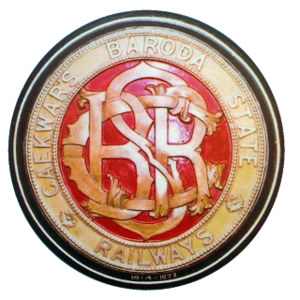Gaekwar's Baroda State Railway: Difference between revisions
Princley State link added |
Opening paragraphs re-written linking to 'Gaekwar's Dabhoi Railway'; Logo added |
||
| Line 1: | Line 1: | ||
{{Line Railways Infobox | {{Line Railways Infobox | ||
|image= | |image=[[File:Gaekwars Baroda State Railways Logo.png|thumb|Gaekwars Baroda State Railways Logo]] | ||
|caption= | |caption= | ||
|route= | |route= | ||
| Line 31: | Line 31: | ||
}} | }} | ||
The Gaekwars of the [[Princely states|Princely ]][[Baroda State]] were responsible for building several metre and narrow gauge lines in and around [[Baroda State]] and the eastern [[Gujerat]] | The '''Gaekwar's Baroda State Railway'''(GBSR) was formed in c.1920. The Gaekwars of the [[Princely states|Princely ]][[Baroda State]] were responsible for building several metre and narrow gauge lines in and around [[Baroda State]] and the eastern [[Gujerat]]. | ||
The | ==Origins of GBSR== | ||
The 2ft 6in/762mm narrow gauge([[Rail_gauge#Narrow_Gauge|NG]]) railway network, known as the '''[[Gaekwar's Dabhoi Railway]]''' commenced with an oxen driven line between [[Dabhoi]] and Miyagam Karjan, a distance of 20 miles(33km) that first opened in 1862. The rails were inadequate for steam locomotives andthe upgraded railway was reopened to traffic in 1873. The network expanded and by 1909 Dabhoi had become an NG railway junction, it had become the centre where the lines from Miyagam, Chandod , Bodeli and Baroda converged with a line length of 92 miles(147km). By the early 1919 the NG network had expanded to 187 miles(299km). | |||
See '''[[Gaekwar's Dabhoi Railway]]''' for details and references | |||
== Development of GBSR== | |||
Additional lines were constructed up to 1929, creating a complex network using two railgauges:- | Additional lines were constructed up to 1929, creating a complex network using two railgauges:- | ||
Revision as of 05:33, 15 October 2016
| Gaekwar's Baroda State Railway | ||
|---|---|---|
[[Image: | ||
| Line of route | ||
| Gauge / mileage | ||
| MG | 308 miles (1944) | |
| 2' 6" NG | 356 miles (1944) | |
| Timeline | ||
| 1949 | Nationalised & merged into BB&CIR | |
| Key locations | ||
| Presidency | Bombay | |
| Stations | Baroda | |
| System agency | ||
| Own agency | ||
| How to interpret this infobox | ||
The Gaekwar's Baroda State Railway(GBSR) was formed in c.1920. The Gaekwars of the Princely Baroda State were responsible for building several metre and narrow gauge lines in and around Baroda State and the eastern Gujerat.
Origins of GBSR
The 2ft 6in/762mm narrow gauge(NG) railway network, known as the Gaekwar's Dabhoi Railway commenced with an oxen driven line between Dabhoi and Miyagam Karjan, a distance of 20 miles(33km) that first opened in 1862. The rails were inadequate for steam locomotives andthe upgraded railway was reopened to traffic in 1873. The network expanded and by 1909 Dabhoi had become an NG railway junction, it had become the centre where the lines from Miyagam, Chandod , Bodeli and Baroda converged with a line length of 92 miles(147km). By the early 1919 the NG network had expanded to 187 miles(299km).
See Gaekwar's Dabhoi Railway for details and references
Development of GBSR
Additional lines were constructed up to 1929, creating a complex network using two railgauges:-
In 1949, the GBSR was merged into the Bombay, Baroda and Central India Railway.
NG Lines constructed and worked by GBSR
- Kosamba-Zankhvav Railway - a NG line opened in 1900